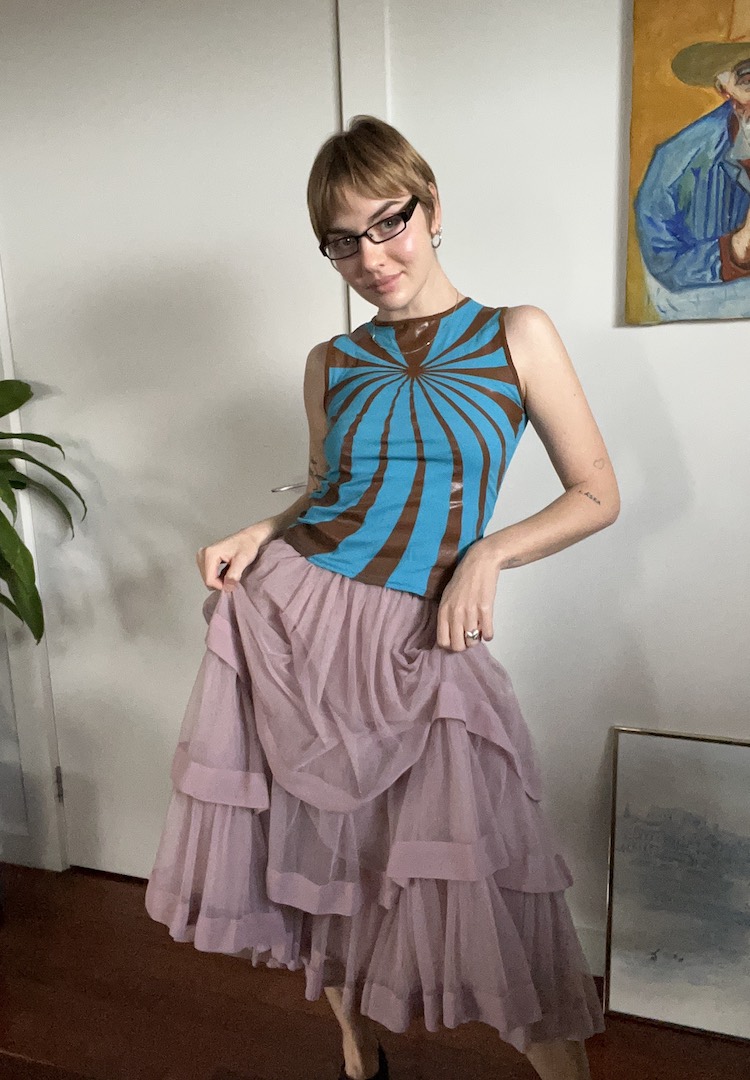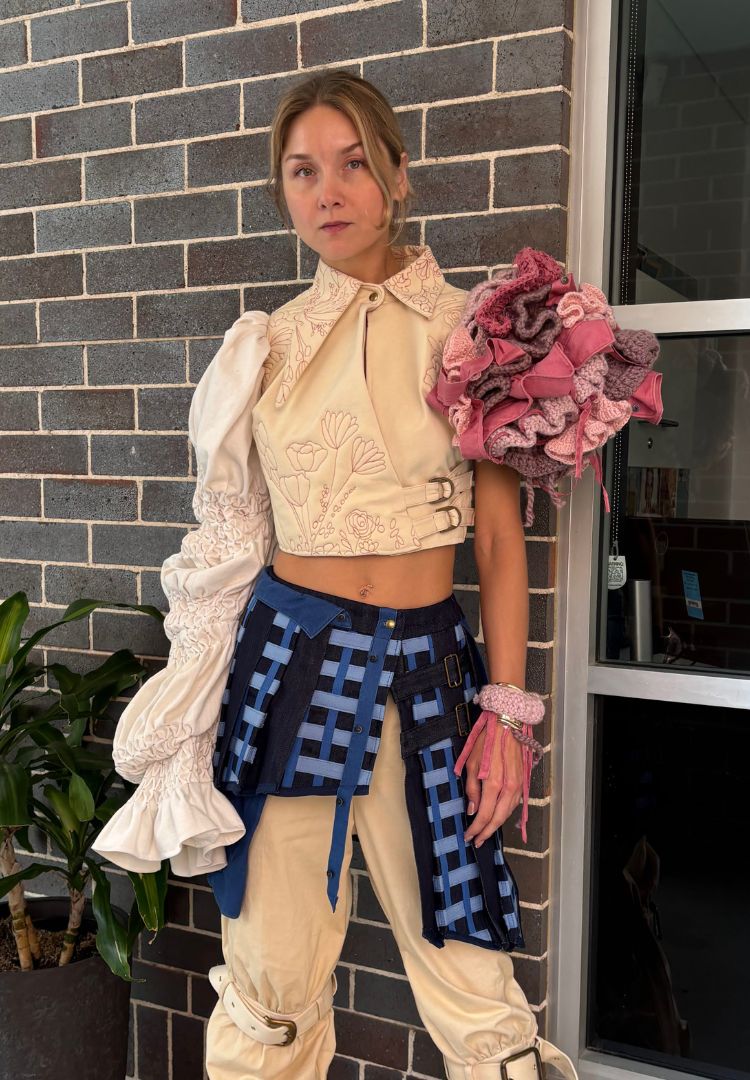“It almost feels mundane”: Australian journalist Jan Fran hasn’t bought new clothes for five years
PHOTOGRAPHY BY MONICA PRONK
WORDS BY MAGGIE ZHOU
“I don’t really even know how I would go back.”
What goes on in the hallowed halls of television networks is a mystery to those sitting couch-side of the telly. Apart from what we glean from dramatised shows, we’re typically only privy to what’s shown to us by presenters with immaculate blowouts on fluorescently lit stages.
Over the phone, Australian journalist, presenter and cohost of Question Everything, Jan Fran tells me there are massive storage rooms in these studio network buildings. Upon entering, you’re met with racks upon racks of glitzy new clothing, often only worn once for an hour or two of recording.
For more fashion news, shoots, articles and features, head to our Fashion section.
The question of where all these clothes were going to end up proved to be the catalyst for her decision to stop purchasing new clothes. That was five years ago. Three years ago, two years into her sartorial challenge, Jan wrote, “When you no longer buy new clothes you start finding old ones in the most surprising places. It’s like your brain gets given a new garment detector.”
Today, Jan still has no plan to backtrack on her pledge. Here, she shares how this has changed her relationship with fashion and her best advice for those wanting to embark on a similar journey.
What’s your current relationship like with clothes?
We’re in a pretty tight relationship. Let’s just say I’ve never had more clothes than what I do now, but they’re all secondhand, all vintage and/or borrowed, and/or used, and/or rented. I guess it’s a kind of eclectic relationship but all based on buying nothing new.
Take me back to that point five years ago when you decided that you didn’t want to buy any new clothes. Can you talk me through your decision-making process?
I’ve always been an op shop shopper; it was kind of the heart of the way I would buy clothes. Then when I started hosting The Feed, which was a nightly show on SBS at the time, I realised that every night I was wearing something different… My cupboard was piling up with these clothes that were cheap – I bought them on ASOS and I bought them at Zara – and they would’ve just been stored at SBS. No one was going to wear them again.
View this post on Instagram
Myself and the stylist at the time decided that rather than amass all of these clothes, why don’t we just try [to not] buy anything? That opens us up to being a lot more creative with what we could wear, which I was totally up for…. [It] sort of stuck. I tried to just do it for a year and just see how we go and now it almost feels mundane. I don’t really even know how I would go back.
What goes on in the wardrobe departments on TV networks?
From my experience working at a bunch of different networks, there’s a good relationship between stylists and brands… it kind of ends up being this reciprocal relationship. [But you] basically [end up] on this hamster wheel of constantly buying new things to look good, to look different, to be ahead of the curve, to look fashionable, to look like you’re in the latest outfit.
What you’ll find with a lot of networks is they usually have this storeroom full of clothes that they’ve just bought over the years for their newsreaders, for their journalists and for their presenters. Like massive rooms full of all different types of clothing that you’re like, ‘Where’s all this going to end up?’. And [the clothes are] not really ever used again, because [they’re] too old or not in fashion anymore… It’s sort of a broken system and unnecessary.
View this post on Instagram
Especially as a woman and especially being in the public eye, there’s a lot of pressure on appearance and what you look like on TV. How do you think this change in your fashion choice has affected you and your career, if at all?
I was never really doing it to set myself apart from other people, but the idea of not buying new clothes – particularly as we talk more and more about sustainability [and] the future of our planet – I feel it resonat[es] with people. Actually, all of the stylists I’ve worked with are really happy to buy vintage and secondhand… They love it because for them it’s this kind of weird and quirky thing that they get to do.
Over the years, are there any outfits that stand out as ones you particularly love?
I have an outfit that my mum wore on her honeymoon in 1984, a beautiful silk top and skirt combination. That to me is a very special outfit that’s almost like an heirloom because it has so much meaning and it has a story behind it. Likewise, I have a coat that my grandmother used to wear, this black woollen coat with massive shoulder pads. It’s a little bit too big on me but I don’t care; that’s another piece that you know I will never part with.
View this post on Instagram
I’ve spoken to a few women who have made similar ‘no buy’ pledges and there’s this connected thread of feeling really invigorated and really creative with fashion limitations. Does that resonate with you?
Oh my god, 100 per cent. It’s like alright, well now I can just wear a silk ’80s power suit, I guess that’s what I’m doing… I think allowing yourself to be creative is genuinely a very joyful experience. That’s one thing that I didn’t expect to be a byproduct.
Half a decade on, you’ve gone to a place where buying no new clothes is so comfortable; you even called it “mundane” before. But I want to take us back to the start of the journey. Were there any growing pains for you?
Yeah, you have to be patient. You’re not always going to get the clothes that you want. You’re not always going to get the size that you want. If you find something, you might then have to pay a little bit more money to get it tailored. It’s not accessible to everyone – when I was pregnant, it was increasingly difficult to find vintage and secondhand stuff. Not impossible, but difficult. There are not a lot of sizes for plus-size women [and] plus-size people. That’s a challenge, that’s the barrier to entry as well.
View this post on Instagram
A lot of the shopping that I do is actually on Instagram. I see something, I like it, I ask them if they can send it to me to try it. I try it – if I like it, I buy it, if I don’t, I send it back. It’s a prolonged process… Sometimes people feel like that’s a growing pain. And also just getting rid of that idea of, ‘I want this now, I should have it now’. Well, so what if you want it now? [You] don’t have it now. The sky doesn’t fall in, you know.
Do you have any advice for others wanting to buy fewer new clothes?
The first piece of advice I would say is [to] be patient. The second piece of advice is [to] be creative. Think about all of the different ways that you could reuse the clothes that you already have totally differently. Could you take them to a tailor to let out hemlines? [Could you] make something shorter, make something longer, make something tighter? [Could you] add some sleeves to something, change the neckline?
Think about borrowing from your friends. If you’ve got a wedding and you have to go ask your friend to wear a dress – that’s not a taboo thing, that’s not an embarrassing thing. It should be something that is done all the time. You have to be the same size, sure, but just open up your cupboard to the people and they, in turn, will open [theirs] up to you.
For more advice on not buying new clothes, try this.













